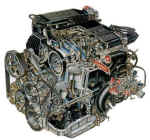 |
The Lancia Integrale 16 valve engine |
Lancia has been a Fiat owned company for many years now. Fiat also owns Ferrari, Alfa Romeo, Innocenti and now Maserati. Their marketing strategy was to engage Ferrari in F1, Alfa Romeo in the Touring Car Championship and of course Lancia in the WRC. Another effect of Fiat's ownership was the use of Fiat engines in the cars of all the other manufacturers. The engine that was chosen for the Integrale was the Fiat 2lt Turbo boosted inline 4. This engine, designed originally by Aurelio Lampredi (a genius who engineered Ferrari's first engines back in 1947), was built around a dual camshaft head. Variations of the Lampredi engine were used, previously, in lots of Fiat and other Fiat owned cars like the Fiat 124, 125, 131, Ritmo, Lancia Beta and Delta. Check out the engine and Integrale 16V specs. The specs of the Integrale 8V are here, the Evoluzione specs here and Lancia rally car pictures here. The engine used in the Integrale is long stroke (bore smaller than stroke) favoring low rev torque more than high rev output. The 8V engine has a more "savage" feeling in it while under 5000rpm than the 16V versions. Remember that the 8V engine uses a larger turbocharger which introduces more lag but delivers substantial benefits in terms of driving pleasure. Of course the 16V version has more "life" in it above the 5000rpm mark. One last word on the Integrale's engine. The unit has the peculiarity to use two balancing, counter rotating shafts in order to filter out vibrations that are inherent to 4 cylinder inline engines. These shafts were not used in competition engines.
Production-wise the number of cars produced by Lancia is:
1986/1987 7,665 units (4WD)
1988/1991 23,004 units (8V and 16V)
1991/1994 12,118 (Evoluzione I, II and III)
A grand total of 47,787 cars where produced.
Compare this number to the total of 7,145 Ford Escort RS Cosworth units.
When Lancia was big in rallying, with the Integrale (86-93), the rally world was a bit less sophisticated than it is nowadays. No computer controlled differentials, for instance, were used in races at that time, they were being developed then. So the Integrale was a solid car (compared to the "fragile" at the time Escort RS Cosworth) that managed to end most of the races it took part in.
The Delta was very remotely based on the S4 Group B car (or was it the other way around...). It's main innovation, technically, was the use of a Torsen (which stands for Torque Sensing) rear differential. This device has extraordinary capabilities. It acts, somewhat, like a viscous coupler only its response to slide is instantaneous. It can also handle partial slip loads automatically whereas other types of mechanical differentials use fixed rates. The TorSen can therefore eliminate slip between wheels or axles for ratios of 10% up to almost 100%, by transferring the engine's torque to the wheel that slips the less. Furthermore Torsen differentials, unlike viscous couplers which are very commonly used in 4 wheel drive cars, act differently when the car accelerates than when it brakes. In fact this is one of the main problems in 4 wheel drive cars. When the car accelerates it is very useful to be able to lock one (or all) of the differentials in case a wheel is spinning. When braking, on the other hand, if one of the wheels locks (due to excessive braking) the differential must not lock otherwise the locked wheel will greatly deteriorate the braking performance or even have the car spinning around its vertical axis. This problem was very elegantly solved by Lancia in the Integrale by the use of the Torsen differential and the braking system's setup detailed further. In case you're wondering why other manufacturers don't use the Torsen the answer is: it costs more. Viscous couplers do lock in braking situations.
The resemblance between the S4 and the Integrale stops at looks. All other parts and car architecture are completely different. The Integrale sports a front, transversally mounted, 4 cylinder engine. The fact the engine is mounted transversally complicates the transmission layout for a 4 wheel drive car. It is particularly important that the shafts driving each wheel are of equal length. This is required to assure similar handling characteristics in both left and right corners. In the Integrale the problem is handled by mounting the gear box at the rear end of the engine (next to the left wheel) then using an internal axle to send back the power to the centrally mounted center differential. This differential uses a classic viscous coupler as a locking device.